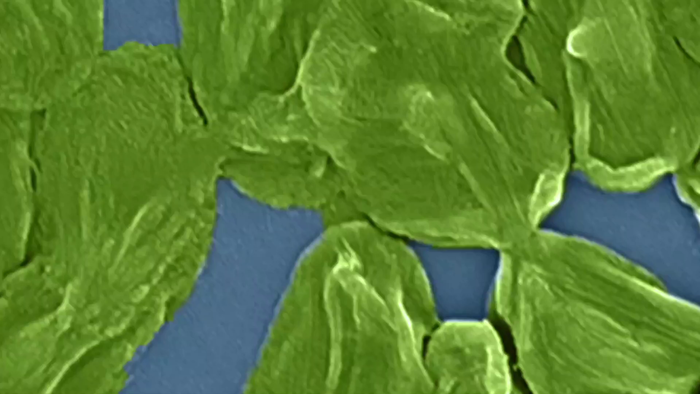NEW YORK, March 14, 2022— Mechanical actuators generate and transfer energy into the machines and systems that we rely on in our daily lives. But despite a century of research, actuators still can’t outperform the abilities of biological muscles in terms of dexterity, power density and efficiency. These limitations are a major bottleneck to improving the functionality of bio-inspired robotics, realizing alternative energy harvesting and storage solutions, and enabling novel smart structures. A research team with the Advanced Science Research Center at the CUNY Graduate Center (CUNY ASRC) has made a novel discovery about a water-responsive material that makes a pivotal step toward addressing these limitations.

Credit: Zhi-Lun Liu
NEW YORK, March 14, 2022— Mechanical actuators generate and transfer energy into the machines and systems that we rely on in our daily lives. But despite a century of research, actuators still can’t outperform the abilities of biological muscles in terms of dexterity, power density and efficiency. These limitations are a major bottleneck to improving the functionality of bio-inspired robotics, realizing alternative energy harvesting and storage solutions, and enabling novel smart structures. A research team with the Advanced Science Research Center at the CUNY Graduate Center (CUNY ASRC) has made a novel discovery about a water-responsive material that makes a pivotal step toward addressing these limitations.
A new paper (“High energy and power density peptidoglycan muscles through super-viscous nanoconfined water”) written by the team and published in Advanced Science describes their work, which has identified peptidoglycan—a mesh-like sugar and amino acids-based polymer that forms the cell wall of most bacteria—as the most powerful actuator material.
“Peptidoglycan can quickly and powerfully expand and contract in response to the absorption and evaporation of water,” said Zhi-Lun Liu, a first co-author of the paper and a Ph.D. student with the CUNY ASRC’s Nanoscience Initiative. “This ability allowed us to use the material to create composite muscles that can actuate micro and macro structures.”
The proof-of-concept demonstrations in this work also show possible strategies for using this new type of water-responsive muscles to perform engineering tasks. “The muscles were able to rapidly bend a stiff, microscale glass fiber in less than two seconds, which is extremely challenging for existing actuators to accomplish,” said Haozhen Wang, also a first co-author of the paper and a Ph.D. student with the CUNY ASRC’s Nanoscience Initiative. “They were also able to forcefully grip, push and pull objects, which is quite promising for engineering systems.”
The researchers’ novel actuators may offer numerous advantages over traditional actuators that usually require high-pressure gas or liquid, high voltage or high temperatures to operate. Peptidoglycan allowed the team to design water responsive actuators that generate powerful actuation by using low-pressure dry and humid air. “This advance could remove design constraints and provide new possibilities for powering and driving soft robots, exoskeletons, wearable devices and miniature engineering systems,” said Xi Chen, Ph.D., the study’s principal investigator and a professor with the CUNY ASRC’s Nanoscience Initiative. “We also hope the fundamental insights of peptidoglycan’s nanofluidic systems will generate an immediate impact and drive more work to create new water-responsive materials that can power many applications, including electricity generation, sensing, thermal management, and locomotion.”
This study was executed in collaboration with Nanoscience and Structural Biology Initiatives at the ASRC. The work was supported with funding from the Office of Naval Research.
About the Advanced Science Research Center
The Advanced Science Research Center at the Graduate Center, CUNY (CUNY ASRC) is a world-leading center of scientific excellence that elevates STEM inquiry and education at CUNY and beyond. The CUNY ASRC’s research initiatives span five distinctive, but broadly interconnected disciplines: nanoscience, photonics, neuroscience, structural biology, and environmental sciences. The center promotes a collaborative, interdisciplinary research culture where renowned and emerging scientists advance their discoveries using state-of-the-art equipment and cutting-edge core facilities.
About The Graduate Center of The City University of New York
The CUNY Graduate Center is a leader in public graduate education devoted to enhancing the public good through pioneering research, serious learning, and reasoned debate. The Graduate Center offers ambitious students nearly 50 doctoral and master’s programs of the highest caliber, taught by top faculty from throughout CUNY — the nation’s largest urban public university. Through its nearly 40 centers, institutes, initiatives, and the Advanced Science Research Center, the Graduate Center influences public policy and discourse and shapes innovation. The Graduate Center’s extensive public programs make it a home for culture and conversation.
###
Journal
Advanced Science
DOI
10.1002/advs.202104697
Method of Research
Experimental study
Subject of Research
Not applicable
Article Title
High energy and power density peptidoglycan muscles through super-viscous nanoconfined water
Article Publication Date
14-Mar-2022




